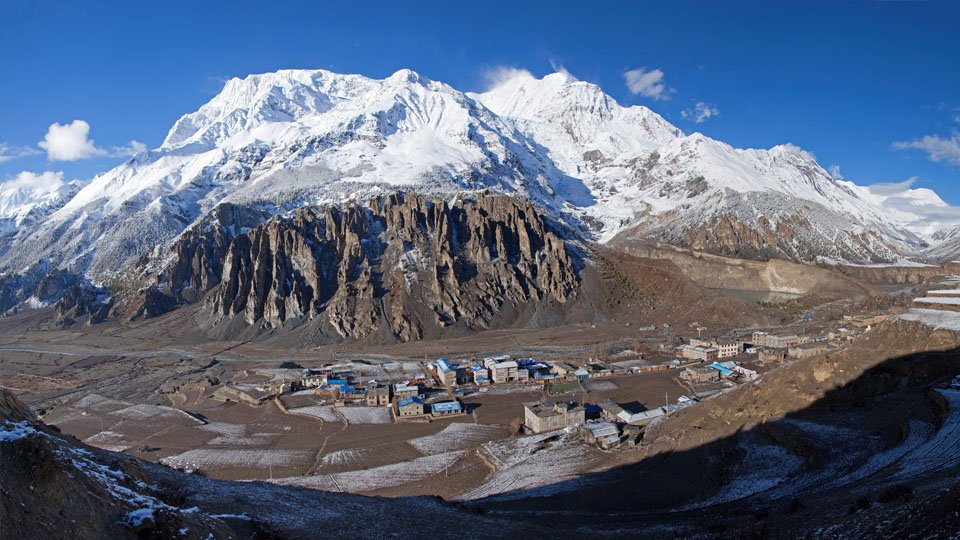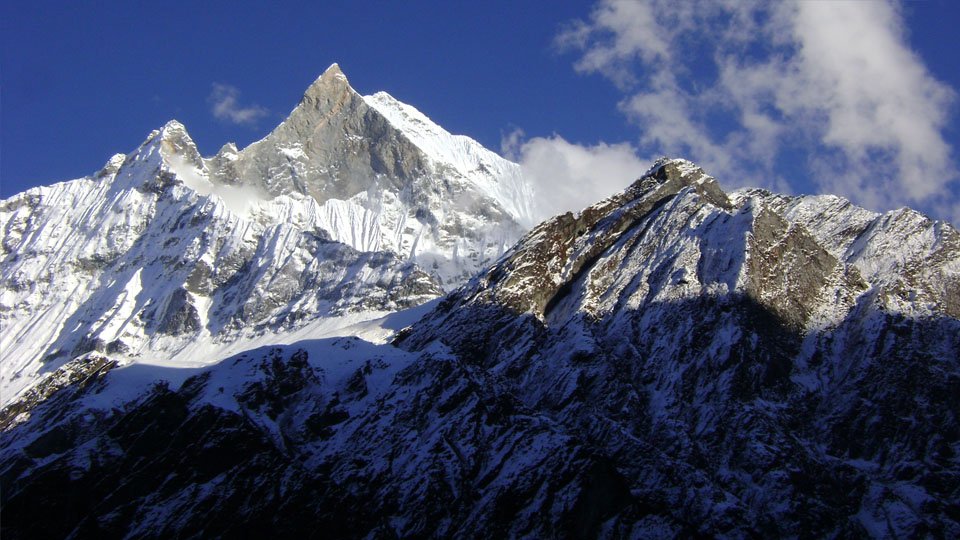Annapurna Circuit trekking is known as the most diverse trek of the world, one of the most popular trekking routes in Nepal too. This trek offers the incredible views of mountain panorama and introduces you to the unique rural traditions and cultures of Nepal Himalayas also.
Highlights of Annapurna Circuit Trek
- Get far from the bustling city life into the peaceful and pristine nature
- Witness stunning views of Annapurna, Lamjung Himal, Dhaulagiri, Nilgiri and more
- Stay in teahouses of small villages
- Cross Thorong La Pass(5,416m)
- Visit Muktinath, other holy temples, and monasteries
- Explore beautiful villages of Braga, Manang, Kagbeni, Jomsom, and Marpha
- Gaze at the breathtaking Annapurna range from Poon Hill
- Natural Hot spring at Tatopani
- Enjoy the lively evening of Pokhara
Overview
Annapurna Circuit Trekking is probably the most loved trekking in Annapurna region which has been considered as one of the best trekking destinations in the world by all trekkers (foreign and local) who has experienced any one of the many treks. Annapurna circuit trek, in particular, evades the Annapurna massif completely in a matter of 21 days. The trek begins from Besisahar and which will ends at Birethanti, Pokhara after reaching to a maximum elevation of 5416 meters at Thorung la pass.
Annapurna Circuit Trekking is an ideal package for those avid trekkers who want to explore the High Himalayan panoramas with the taste of beautiful culture and traditions of rural Nepal. The Annapurna Circuit Trekking route follows interesting villages and lush forests of rhododendrons, pine and oak which add the beauty to trail. The whispering rivers and chirping birds will make the trip more exciting.
Thorung la pass is the highpoint of the trek along with the mountain views and the pristine landscape along the trail. The Annapurna Circuit Trekking the tricky and snowy trails pose a challenge which becomes a great feat once you reach the top of the pass and enjoy the surrounding majestic views. On the route we follow the Marsyangdi River with crossing its clear waters over suspension bridges many times; we go from traditional gorgeous villages, terraced hills to yak meadowlands at the bases of mountain peaks.
From Tibetan-styled villages, Gompas, a monastery, and holy Hindu temple- Muktinath, the Annapurna Circuit Trekking Trail is filled with cultural and religious heritages. In addition to that, the calmness of the trails and the warm hospitality of the people make the trek a truly inspiring experience. The Gurung, Thakali and other traditional villages provide a glimpse into the life of the traditional people living around the majestic mountains. With the delights of challenging trails, high elevation destinations, natural and cultural diversities, Annapurna circuit trek is truly one of the best adventures of a lifetime.
If you want Annapurna Circuit Trek in low cost than you may modify the itinerary with no acclimatization days. However, walking continuously in the higher altitude without acclimatization days is risky. So, only physically fit peoples and peoples with previous experience of walking in the higher Himalayas can complete this trip without taking extra days for rest.
Outline Itinerary
| Day | Program | Elevation |
|---|---|---|
| 1 |
Arrival to TIA airport. Pick up from there then check in to hotel in Kathmandu Upon arrival in Kathmandu.
|
1440m |
| 2 | Kathmandu to Besisahara to Bhulbhuleby public Bus | 760m-840m |
| 3 | Bhulbhule to Jagat | 1400m |
| 4 | Jagat to Dharapani | 1960m |
| 5 | Dharapani to Chame | 2620m |
| 6 | Chame to Pisang | 3190m |
| 7 | Pisang to Manang | 3540m |
| 8 | Manang Acclimatization Day | 3519m |
| 9 | Manang to Yak Kharka or churi Ledar | 4020m/4200m |
| 10 | Letdar to ThorangPhedi | 4440m |
| 11 | Thorang Phedi via Thorang La Pass – Muktinath | 5416m-3800m |
| 12 | Muktinath to Marpha | |
| 13 | Marpha to Ghasa | 2080m |
| 14 | Ghasa to Tatopani | 1190m |
| 15 | Tatopani to Ghorepani | 2834m |
| 16 | Ghorepani to Pokhara via Poon Hill | 1495m |
| 17 | Return back to Kathmandu by tourist bus. | 1440m |
| 18 | Farewell |
Itinerary
Includes/Excludes
Cost Include
- Airport Pick and Drop via Private Transport
- One night stay at the hotel in Kathmandu including breakfast with twin sharing basic.
- One night stay at the hotel in Pokhara including breakfast with twin sharing basic.
- All government taxes and Annapurna conservation entry fees.
- Kathmandu to Besisahara via local transport
- Pokhara to Kathmandu via Tourist Bus
- TIMS CARD (Trekking Information Management System).
- Required number of experienced English speaking guides and support staff (we pay for their daily wages, insurances, trekking equipment, food and accommodation).
- 16 days porter wages and his insurances/meals/accommodation/equipment
- 16 days guide wages and his insurances/meals/accommodation/equipment
- Rescue arrangement in emergency situation & worst weather condition
- 14 nights Lodge accommodation during the trek on tea house services.
- Necessary ground transportation depending upon your request (via tourist bus or private vehicle).
- Trekking Ending Point to Pokhara
- Trekking poles, sleeping bag/duffle bag (we provide these if necessary).
- Trekking maps.
- Rubbish disposal.
- Our service charge and government taxes.
Cost Exclude
- All meals in Kathmandu and during trekking
- Hotel stay in Kathmandu.
- Tips to guides and support staff.
- Additional costs in case of emergency (You must have adequate travel insurance to cover any kind of emergencies, such as ground transportation & Heli recue/medical/hospitalization. Medical etc).
- Your International flight ticket airfare
- Energetic chocolate/energy drinks/alcohol/mineral water/cigarettes/packing food snacks etc
- Additional medication for altitude sickness (Acetazolamide etc).
- Personal expenses and any other unforeseen expenses, such as Laundry/WIFI on trek/phone call
- Personal trekking equipment.
- Nepal entry visa fees which can get up on your arrival in Kathmandu airport
- Sightseeing tour and All the entrance fees of temple in Kathmandu
- Services not mentioned herein
FAQs
It depends on the individuals’ adaptation of walking in any situation and at any circumstances. It depends on the location and choice of trekkers. Both difficult as well as easy treks are available. Difficulty of the treks depends on the region of the trek and duration of it. Shorter treks tend to be easier while longer ones require some physical fitness.
Completely, we assure the safety and security of the women travelling with us. We will provide the privacy that the women need. We will also give you a personal room on lodge and personal tent for camping while trekking.
Tea House Trek – is a trek during which at the end of each trekking day you stay for overnight in Tea Houses. “Trekking Guide Team Adventure” also organizes Camping Treks during which you stay for overnight in tents which our guides will set up for you and food during such treks will be cooked by our experienced cook.
Yes, you can get it in Tribhuvan International Airport in Kathmandu. As you arrive to airport fill the form and proceed to the visa line. You have to pay 25US$ for 15 days of visa from the day of issue, 40US$ for 30days and 100US$ for 90 days of tourist visa. For this you have to bring two passport size photos.
There are enough airline companies operating daily flights from Middle East of Kathmandu. Kathmandu only has got only international airport in Nepal so, where ever you are coming from you must come through tribhuvan international airport.
For coming to Nepal you should have both medical and Rescue evacuation insurance. Yes you can get it here too, but we recommend purchasing it in your own country to avoid any last minute hassle and basal.
In Nepal it rains a lot between Junes to August. You too can enjoy great treks during this period of year in rain shadow region. But if you planning for more popular trek autumn and spring is the best time. As during this period climate will be moderate and will favorable for the trekking.
Nepal has modern banking facilities having branches of some international bank. Almost all foreign currency along with credit card such as American Express, Visa and Master card are accepted. Nepal also has ATM facilities.
We suggest you to book your trip in advance to avoid the disappointment and hassles. We too will make an effort to accommodate last minute bookings but some time due to the last minute planning we may unintentionally make few mistake which may offend you so it will be better to do advance booking.
Yes, our agency representative will pick you from airport. We will be displaying our placard of your name with our agency name
This depends on the destination you will be at and package, facilities you may choose . However our trip profile will give you information about how to budget form additional meals, optional excursions and extra expenses that might occur in any specific trip.
Since we are Nepal based company we refer to arrange your international flights from your home town. But domestic flight ticket will be included in our package. Other help like river rafting, city guided tour, mountain flight, jungle safari will be provided according to your necessities.
If you are in good physical condition then you do not require any hiking experience for short trekking. But if you are planning for the longer ones then you should do long day hikes at your home.
Permit is not required for trekking in Everest, Annapurna, Langtang and some other regions. However, conservation permits or National park permits are required. There are few restricted trekking areas in Nepal where trekking permits are required.
All the meals are prepared with high standards of hygiene, fruit and vegetables are soaked in iodine before preparation. Most of lodges serve boiled and filter water which is safe. It is also possible to buy the bottle of mineral water in the trek.
All of our guides are trained with first aid and have basic idea about the physical problems that may arise during trekking. If an emergency occur then we will cover initial expenses of rescue operation as these expenses will need to be recovered from your insurance company. For minor cases there are health posts established by foreign doctors and many are staffed by overseas personnel.
You need to pay 30% of total price as advance deposit to conform reservation before arriving to Nepal. Rest of the payment can be paid after arrival.
You can bring power bars, cereal bars and similar high energy foods, powder Gatorade is also recommended to fight dehydration.
In the way in many villages along the popular trekking routes you can find telephones from where you can make international calls. And now a days we have the internet facilities most of the trekking destination.
You can do all day walk, where you stay overnight (or several nights) at three activities in Nepal, but they are quite different things. Trekking is a multi-the place you’ve walked to.
Hiking generally refers to a one-day walk. It might be two hours or eight, but if it takes place within a single day, it’ll probably be referred to as a hike.
Mountain climbing is another thing entirely. It takes special equipment, training and comes with more risk. Neither trekking nor hiking require any special skill, other than the ability to walk.





